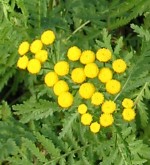 Common tansy is a herbaceous perennial and a member of the aster family, Asteraceae, that also includes daisy, yarrow, and lettuce. It is native to Europe and Asia but was introduced into North America by colonists before 1631 for medicinal and horticultural purposes and now occurs throughout much of northern US. Plants like well-drained soil with full or partial sun and can be found in recently disturbed sites such as roadsides, railroad right-of-ways, hedgerows, ditches, vacant lots, old fields, pastures, and river banks. USDA Hardiness Zones 3-8
Common tansy is a herbaceous perennial and a member of the aster family, Asteraceae, that also includes daisy, yarrow, and lettuce. It is native to Europe and Asia but was introduced into North America by colonists before 1631 for medicinal and horticultural purposes and now occurs throughout much of northern US. Plants like well-drained soil with full or partial sun and can be found in recently disturbed sites such as roadsides, railroad right-of-ways, hedgerows, ditches, vacant lots, old fields, pastures, and river banks. USDA Hardiness Zones 3-8
Description: Common tansy grows from an extensive spreading root system composed of fibrous roots and rhizomes. It grows 1-4′ tall , is branched at the top, and has a thick upright stem that may be hairy or hairless. The green leaves are fern-like, 6-8″ long, and give off a pungent odor when crushed. They are pinnately compound and leaflets have toothed margins. The button-like flower heads are 1/2 inch wide and appear in summer in terminal flat-topped clusters. Each flower head consists of yellow disc flowers with ray flowers absent or reduced. The fruit is a single seeded achene and a single plant can produce up to 50,000 that remain viable in the soil for just one season. Plants spread by seed and rhizomes.
Control: Control of common tansy is best accomplish by a combination of site improvement to prevent establishment of the plants, and both mechanical and chemical methods. Pulling, digging or mowing seedlings or plants can reduce seed production if done before seed set but is likely to encourage sprouting of new plants from root fragments. Herbicides such as 2,4-D, glyphosate , a blend of 2,4-D and clopyralid, or picloram are effective especially if wiped on the foliage up to the early flowering stage, but may have to be repeated.